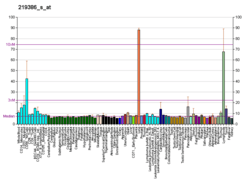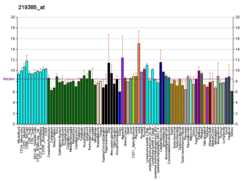SLAM family member 8 is a protein that in humans is encoded by the SLAMF8 gene.[5][6]
Function
This gene encodes a member of the CD2 family of cell surface proteins involved in lymphocyte activation. These proteins are characterized by Ig domains. This protein is expressed in lymphoid tissues, and studies of a similar protein in mouse suggest that it may function during B cell lineage commitment. The gene is found in a region of chromosome 1 containing many CD2 genes.[6]
References
- 1 2 3 GRCh38: Ensembl release 89: ENSG00000158714 - Ensembl, May 2017
- 1 2 3 GRCm38: Ensembl release 89: ENSMUSG00000053318 - Ensembl, May 2017
- ↑ "Human PubMed Reference:".
- ↑ "Mouse PubMed Reference:".
- ↑ Kingsbury GA, Feeney LA, Nong Y, Calandra SA, Murphy CJ, Corcoran JM, Wang Y, Prabhu Das MR, Busfield SJ, Fraser CC, Villeval JL (May 2001). "Cloning, expression, and function of BLAME, a novel member of the CD2 family". Journal of Immunology. 166 (9): 5675–80. doi:10.4049/jimmunol.166.9.5675. PMID 11313408.
- 1 2 "Entrez Gene: SLAMF8 SLAM family member 8".





